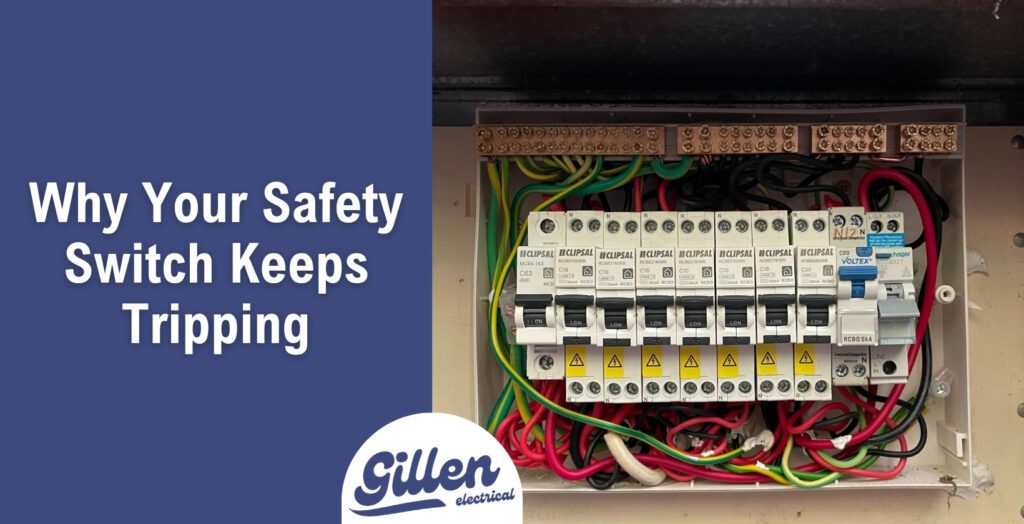Your safety switch keeps tripping because of faulty appliances, overloaded circuits, nuisance tripping, bad wiring or moisture, power surges, or a defective RCD.
Safety switches, or RCDs, cut power when they detect current leakage to earth. In commercial settings, commercial electrical maintenance often uncovers overlooked faults that would otherwise trip RCDs regularly. A constantly tripping switch points to an underlying problem that needs isolating fast.
Our guide breaks down the 6 main reasons why a safety switch keeps tripping and ways to fix them.
6 Reasons Your RCD is Tripping
Some trips are isolated and harmless, but repeated triggers suggest a more serious fault. The cause can be anything from bad wiring to external events like lightning.
Here are the 6 reasons your RCD is tripping:

1. Faulty Appliance
Appliances with internal faults can leak current, which triggers your RCD to cut the power. Washing machines, kettles, and old fridges are common appliances that can leak cause tripping.
To isolate the issue, unplug everything on the circuit and reconnect one item at a time. When the RCD trips again, you’ve found the device causing the fault.
Some faults show visible damage like scorch marks, but others remain hidden until tested with a multimeter. Always replace rather than repair if the fault sits inside the appliance’s sealed components.
2. Circuit Overload
A circuit becomes overloaded when it carries more current than it’s rated to handle. This trips the RCD or the circuit breaker as a protective response.
Common signs include lights dimming or breakers flicking off during peak appliance use. Kitchens and home offices with many plugged-in devices often cause the load to spike.
If the issue happens during an electrical emergency, unplug non-essential appliances and contact a licensed electrician. They may recommend running new circuits or redistributing load across phases.
3. Nuisance Tripping
Not all tripping means something is dangerously wrong — some RCDs activate due to minor fluctuations. These nuisance trips often occur during storms or when large appliances switch on.
Fridges, air conditioners, or pool pumps may cause transient surges that trigger overly sensitive RCDs. This happens more with cheaper devices or ageing RCD units.
Installing a type A or type B RCD with surge filtering reduces these events. If nuisance tripping becomes frequent, an upgrade or isolation test is the best fix.
4. Faulty Wiring or Moisture
Wiring hidden behind walls can degrade over time or be damaged by pests or heat. Moisture from leaks or poor sealing introduces current leakage paths that trip the RCD.
These issues appear most in wet areas like bathrooms, laundries, or outdoor zones. They also rank high among the signs of electrical hazards in older properties.
Replacing wiring or sealing conduits may be required after a proper fault diagnosis. A moisture meter or insulation resistance test confirms the source before work begins.
5. Lightning or Surges
External surges caused by lightning strikes or nearby faults can trigger instant trips. These events don’t indicate a fault with your system, but protection still activates as designed.
Surge events can damage electronics even if the RCD resets. Sometimes you’ll find appliances partially working but not performing properly after a storm.
Devices like surge protectors and isolation transformers, along with proper earthing, help prevent RCD trips caused by power surges. For example, whole-house surge protectors can shield multiple circuits during storms. This becomes a necessary addition to any switchboard setup for properties in surge-prone areas.
6. Defective RCD Itself
Sometimes the RCD unit itself is the problem. RCDs can degrade over time due to frequent tripping, exposure to heat, or failure.
A defective RCD may trip with no load or at random times, even on an empty circuit. This points to internal wear, not external faults.
Testing involves using an RCD tester to simulate fault conditions and measure trip times. If the unit fails to meet spec, it has to be replaced.
How to Find Out What’s Tripping the RCD?
In order to find out what’s tripping an RCD, follow these 4 steps:
Step 1: Unplug all appliances on the affected circuit
A faulty appliance is the most common cause of RCD tripping. Turn off the safety switch and unplug every device, including hidden or infrequently used items like fridges, heaters, and power boards.
Step 2: Reset the safety switch (RCD)
Once everything is unplugged, try resetting the RCD. If it stays on, that confirms the electrical fault is coming from something you unplugged and not the wiring.
Step 3: Plug in appliances one at a time
Reconnect each appliance slowly, waiting 10-15 seconds between turning on each appliance. If the safety switch trips again, you’ve likely found the faulty item. Appliances like kettles, washing machines, or older fridges often are the cause of a tripped RCD.
Step 4: Contact a licenced electrician if the switch still trips
If the RCD won’t reset or trips even with nothing connected, the fault may lie in the wiring, moisture ingress, or the RCD itself. In this case, only a licenced electrician can perform proper testing and electrical repairs. Do not keep resetting a tripping switch without contacting a licenced electrician

